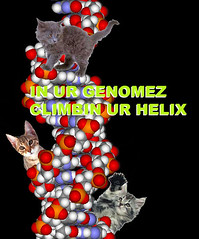Cat Genome (lightly - 65%) sequenced!

RD reminds us that we have been remiss in not reporting that the housecat (specifically, the Abyssinian) genome has been sequenced. Now we'll be able to eradicate all those terrible tendencies toward eye-gouging seen in certain members of that family.
Here are the details:
Auntie Beeb: Cat joins exclusive genome club
A pedigree cat called Cinnamon has made scientific history by becoming the first feline to have its DNA decoded.
The domestic cat now joins the select club of mammals whose genome has been deciphered - including dogs, chimps, rats, mice, cows and people.
The genome map is expected to shed light on both feline and human disease.
Cats get hundreds of illnesses similar to human ones, including a feline version of HIV, known as FIV, and a hereditary form of blindness.
Cinnamon, a four-year-old Abyssinian cat, is descended from lab cats bred to develop retinitis pigmentosa, a degenerative eye disease, also found in humans, which can lead to blindness.
Earlier this year, with the help of the sequence, scientists found the gene change, or mutation, that causes the condition in cats.
Analysis of the cat genome sequence could also shed light on everything from evolution to the origins of feline domestication, they say.
- and here's some more technical jargon from Science Daily (Like we need any of that!): Domestic Cat Genome Sequenced
ScienceDaily (Nov. 1, 2007) — The DNA of a 4-year-old Abyssinian cat named Cinnamon, whose well-documented lineage can be traced back several generations to Sweden, has been sequenced. Cinnamon is one of several mammals that are currently being analyzed using "light" (two-fold) genome sequence coverage. To make sense of Cinnamon's raw sequence data, a multi-center collaboration of scientists leveraged information from previously sequenced mammalian genomes as well as previous gene-mapping studies in the cat. In doing so, they found that Cinnamon's sequences spanned about 65% of the euchromatic (gene-containing) regions of the feline genome
The similarity between the cat genome and six recently completed mammalian genomes (human, chimpanzee, mouse, rat, dog, and cow) allowed the scientists to identify 20,285 putative genes in the cat genome. The comparison also revealed hundreds of chromosomal rearrangements that have occurred among the different lineages of mammals since they diverged from a diminutive ancestor that roamed the earth among the dinosaurs some 100 million years ago.
The genome sequence analysis is certainly expected to lead to health benefits for domestic cats, 90 million of which are owned by Americans alone, according to The Humane Society. But the domestic cat also serves as an excellent model for human disease, which is one reason why the National Human Genome Research Institute (NHGRI) initially authorized the cat genome sequencing project three years ago.


0 Comments:
Post a Comment
<< Home